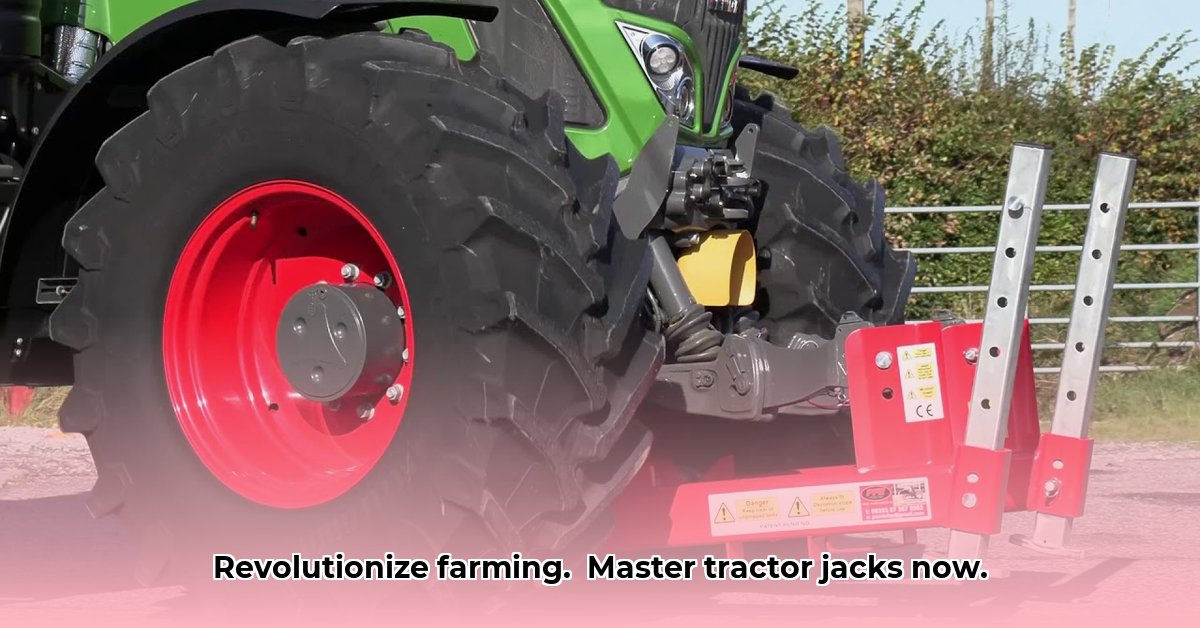
Tractor Jacks: Essential Tools for Efficient and Sustainable Farming
Tractor jacks, often overlooked, are crucial for efficient and safe farm operations. These essential tools simplify maintenance and repairs, minimizing downtime and enhancing overall farm productivity. Proper use of tractor jacks contributes to a safer working environment, preventing injuries associated with improperly lifting heavy equipment.
Understanding the Importance of Tractor Jacks in Farm Efficiency
Modern tractors are substantial investments. Their maintenance and repair require specialized tools that can safely handle their considerable weight. Tractor jacks provide the necessary support for tasks such as tire changes, engine maintenance, and other repairs, improving the efficiency of these processes. Using a reliable jack not only saves time and labor but also dramatically reduces the risk of injury or equipment damage.
Selecting the Right Tractor Jack for Your Needs
Several types of tractor jacks cater to varying farm needs and budgets. The optimal choice depends on the tractor's size and weight, budget constraints, and frequency of use.
Bottle Jacks: Portable and compact, ideal for smaller tractors and quick tasks. Their ease of storage and transport makes them convenient for farms with limited space. However, they might not be suitable for heavier tractors.
Floor Jacks: These heavy-duty jacks are designed for larger tractors, offering enhanced lifting capacity and stability. While less portable, they provide the necessary strength for substantial lifting tasks.
Scissor Jacks: Offering a wider, more stable base compared to bottle jacks, these jacks are generally easier to operate. They offer a balance of portability and lifting capacity, making them a versatile choice for many farms.
Careful consideration of your tractor's weight and maintenance requirements is critical. Investing in a robust jack capable of handling the workload is far more economical in the long run than risking damage with an undersized jack.
Safe and Efficient Tractor Jack Usage: A Step-by-Step Guide
Safe jacking procedures are paramount. Always adhere to these steps:
- Prepare the Ground: Ensure a level, firm surface, free of debris. Use planks on soft ground to distribute weight evenly and prevent sinking.
- Locate Jacking Points: Consult your tractor's manual to identify approved jacking points. Lifting from unapproved locations could result in damage or injury.
- Position the Jack: Securely place the jack under the designated jacking point, ensuring its stability and firm placement.
- Lift Slowly: Raise the tractor gradually and evenly; avoid abrupt movements. Regularly monitor the jack's stability throughout the lifting process.
- Employ Jack Stands: Upon reaching the desired height, immediately place sturdy jack stands under the frame for supplementary support, preventing accidental falls.
- Lower Carefully: Lower the tractor gradually and steadily, maintaining jack stability throughout.
Maintaining Your Tractor Jack for Extended Lifespan
Regular maintenance is crucial for your jack's longevity and performance.
- Regular Inspection: Inspect your jack before each use for damage, leaks, or wear, paying particular attention to the lifting mechanism and base.
- Lubricate Moving Parts: Keep moving parts lubricated according to manufacturer instructions to prevent rust and ensure smooth operation.
- Proper Storage: Store your jack in a clean, dry environment, away from extreme temperatures and moisture, to prevent corrosion and damage.
A high-quality tractor jack is a worthwhile long-term investment that minimizes downtime and prevents costly repairs from equipment damage or injury. While the initial cost might be higher, the long-term savings and safety benefits far outweigh the expense.
Precision Farming: Minimizing Pesticide Use for Sustainable Agriculture
Precision agriculture offers innovative ways to optimize resource use. Precision spraying, in particular, significantly reduces pesticide use while protecting the environment. This technology uses GPS, sensors, and software to target pesticide application only to areas with infestations, minimizing unnecessary chemical use.
Key Takeaways:
- Precision spraying offers a powerful solution for reducing pesticide use, safeguarding both the environment and farm profitability.
- The economic feasibility of precision spraying hinges on factors like farm size, crop type, and the initial investment in technology.
- Successful implementation mandates accurate sensors, reliable GPS systems, and high-quality field mapping capabilities.
This targeted approach drastically reduces chemical usage, leading to cost savings, improved environmental sustainability, and healthier crops. The economic and environmental benefits of precision spraying depend heavily on the specific farm conditions and the technology employed. Accurate data acquisition and analysis are crucial for optimal results. Careful consideration should be given to the initial investment cost, technology integration, and ongoing maintenance, alongside the potential operational challenges and environmental considerations.